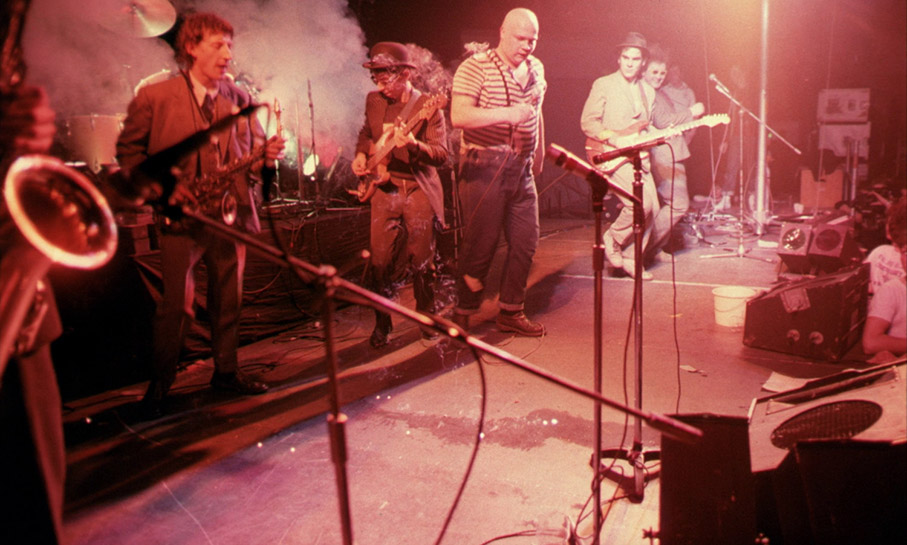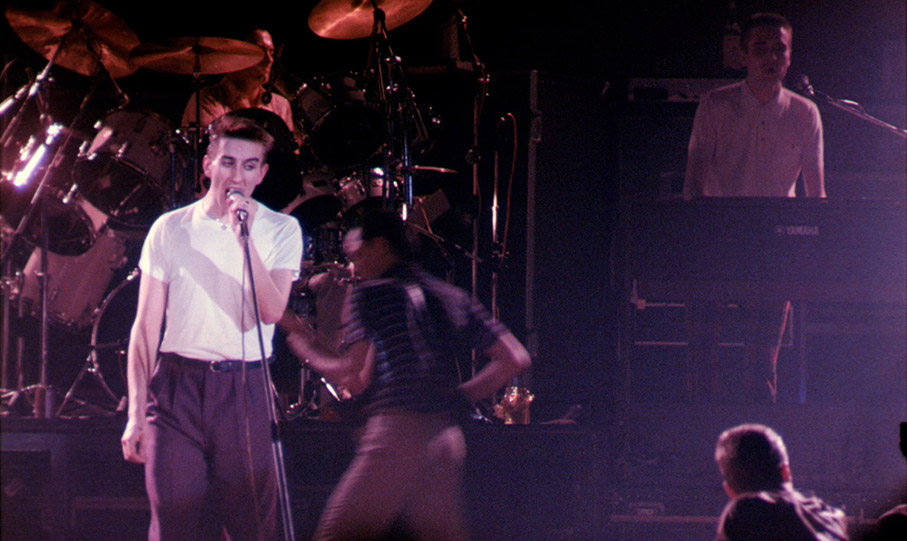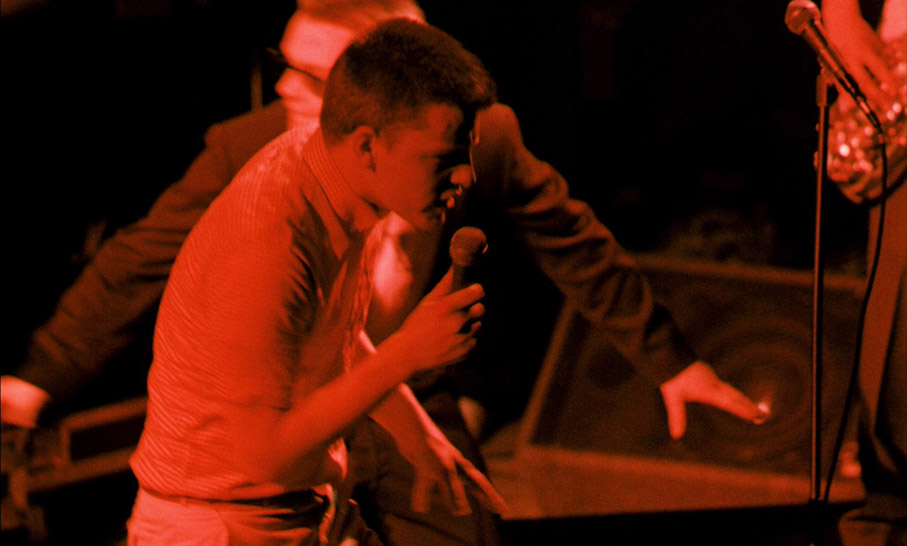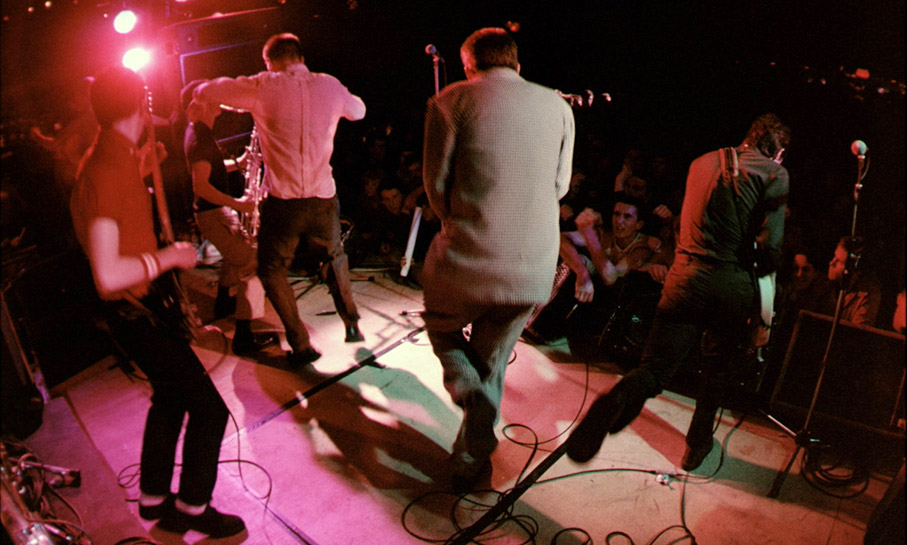|
"All over Britain, signs like this flash their nightly invitation and in response more than half a million people go dancing every week, all the year round."
That's how Dance Craze opens, with a voiceover backed by shots of neon signs and men and women queueing up to, indeed, go dancing. Well, the film is of course a documentary but it's not the one it at first appears to be. However, halfway through, as an interlude, we cut back to extracts from newsreels from the 1950s, with then-teenagers talking to camera. Hard to think that they'd be in their eighties now, but then again Dance Craze itself is over forty years old and several of the people featured are no longer with us.

Dance Craze is a showcase for two-tone (or 2 tone if you prefer), a style of music that was at its height around the time the film was made, in 1981. It fused elements of Jamaican music (ska, rocksteady, reggae) with the then-current punk and new wave. It originated in the Midlands, mostly in and around Coventry, and many of the bands had interracial lineups, the aim of the music to unite the races at a time of racial tensions in a Britain then governed by Margaret Thatcher's Conservative government. Some of the bands featured women prominently, such as The Selecter with frontwoman Pauline Black, and the all-female The Bodysnatchers. 2 Tone was also the name of the record label to which many of the key acts were signed. With prominent Jamaican-style bass, this was music that was designed to be danced to, and the audiences in this film do indeed dance. The lyrics often slipped in political comment, with The Specials's "Ghost Town" hitting number one in the charts as riots broke out in several British cities.
The film was directed by Joe Massot, who had previous form with concert movies. He had previously co-directed Led Zeppelin in The Song Remains the Same, which features excellent concert footage from Madison Square Garden, though the less said about some extended fantasy sequences intended to illuminate the inner lives of the band, the better. Also music-related was the 1968 psychedelic-era relic Wonderwall, which is most notable now for a score by George Harrison, the first solo project by a Beatle. Dance Craze is a concert movie, coming on like a festival of two-tone, with no less than six different bands, but it was filmed at different gigs on different nights, the results edited together. The Beat's gig was filmed during their US tour.
It's hard to pick out highlights, with the six bands present being leaders in the two-tone movement. We start and end with The Specials, but in between we see Madness, Bad Manners (with their ebullient frontman Buster Bloodvessel), The Bodysnatchers, The Selecter and The Beat (who had to be renamed The English Beat or The British Beat overseas due to local bands with the same name). Massot and his DP Joe Dunton film the numbers from the stage, using Steadicams (sometimes operated by its inventor Garrett Brown) extensively. The film was shot in 35mm, inaugurating the Super 35 process (for more about this, see "sound and vision" below), and the sound recorded on twenty-four-track equipment. The film was released in 70mm to make use of the possibilities of six-track magnetic Dolby Stereo, then far in advance of what was possible with 35mm optical Dolby, though such prints were also struck and played in what would have been then the few Dolby-equipped cinemas in the UK. The film opened in 70mm at the Dominion on Tottenham Court Road, London, and had a limited 35mm release.

The concert (or festival) movie is something of a dying art, with television (and stereo television sound) now more of a way to experience a gig you didn't attend. The great years of the format began in the Sixties, with Monterey Pop and Woodstock and others, and the genre had a mid-Eighties peak with Stop Making Sense. Dance Craze is worthy of being counted in that company, and for the most part of an hour and a half it's infectious, particularly if you can remember the music of forty-plus years ago. Play loud and dance.
Dance Craze is released by the BFI on a single Blu-ray disc, encoded for Region B only. The film had a U certificate on its original release, and this Blu-ray transfer has the original BBFC yellow card at the start. Assuming this version is the same as the original release, and I've heard nothing to suggest that it isn't, I can only conclude that the BBFC examiners weren't listening to the song lyrics, as they include one "fucking" and references to racism and venereal disease. The film is now rated 12.
The film was shot in 35mm using the new Super 35 process. This process (also known as Super Techniscope or System 35 in its early days) was a variation on the old 1950s process SuperScope 235. It exposed a greater picture area on the 35mm stock, including the area where the soundtrack would normally be, giving a native aspect ratio of 1.66:1. Then, via an optical printer, the film was transferred to conventional film prints, with the picture cropped to a wider ratio (most usually 2.39:1 or 1.85:1) as required. Dance Craze was the first Super 35 feature, and the process was used for the first time on a dramatic film by director Hugh Hudson and DP John Alcott on Greystoke: The Legend of Tarzan, Lord of the Apes (1984). It was used to great effect on Top Gun (1986) as cameras with anamorphic lenses would have been too heavy to capture the scenes in plane cockpits. Super 35 went on to be widely used, inevitably less so now when the majority of films are digitally-captured. One advantage of the process is that the greater negative area meant less loss of resolution when the film was blown up to 70mm, as Dance Craze was.
The Blu-ray transfer is in the ratio of 1.66:1 and is derived from a 4K scan and remaster of the only surviving 70mm print, from the personal collection of Joe Dunton. (The original camera negative is lost, and surviving 35mm prints are in far worse condition.) Most of the film is shot on stage, with often reddish concert lighting, and there's plenty of grain, but I don't doubt that this reflects the way the film has always looked. The newsreel interlude in the middle is in black and white and presented in 1.37:1.

As mentioned above, the film was blown up to 70mm to take advantage of the possibilities of six-track Dolby magnetic stereo, which at the time mostly comprised three front channels and a mono surround, with two low-frequency-enhancement (LFE, i.e. bass) channels, or 4.2 in modern parlance. (The now more familiar 5.1 configuration – three front channels, left and right surround, single LFE – had been pioneered two years earlier with the 70mm release of Apocalypse Now, but most films released in 70mm retained the 4.2 "Baby Boom" format, at least until digital sound arrived a decade later.) This is rendered on Blu-ray as LPCM Stereo (2.0) which plays in surround (and presumably replicates the Dolby Stereo mix on 35mm prints), DTS-HD MA 5.1, and a new Dolby Atmos mix. I'm not Atmos-enabled, and this track defaulted to TrueHD 7.1 on my system and is quieter than the other mixes. There's little to choose between them, which don't have a lot of directional sound other than putting the audience into the surrounds, but the instruments are clear and well-balanced and the subwoofer on the 5.1 helps out with the all-important bass.
There are English hard-of-hearing subtitles available, which other than the opening narration and the newsreel interlude, mostly render the song lyrics, useful if you always wanted to know what they were singing. There is also a song-selection menu.
Rudies Come Back (34:07)
This documentary, made as part of the Arena series, was broadcast on BBC2 on Wednesday 12 March 1980, repeated the following Monday. Journalist Adrian Thrills travels to Coventry to investigate the new happening thing of two-tone. Along the way, he interviews members of The Specials and The Selecter. This is inevitably an entry-level piece designed to introduce a wider audience, or at least one which wasn't watching Top of the Pops, to this new sound, but it does include some good concert footage. There's also a C-word which I suspect was blanked out on its television broadcasts.
Outtakes
Songs that didn't make the final cut of the film, and alternate versions of some which did. Visually the quality is quite rough in places, presented in 1.33:1 with mono sound. The numbers are: "Carry Go Bring Come" by The Selecter (3:15), "One Step Beyond" by Madness (2:34), "Do Nothing" by The Specials (3:43), "Night Boat to Cairo" by Madness (3:12) and "Enjoy Yourself" by The Specials (3:57).

Restoration demonstration (1:45)
As it says, comparing and contrasting the 70mm print before and after remastering and also throwing in some distinctly scratched-up footage from a surviving 35mm print.
Booklet
The BFI's booklet, available with the first pressing only, runs to twenty pages. It begins with "Three Minute Heroes", an essay by Johnny Mains which begins by highlighting how the social conditions of forty-two years ago are mirrored by those today, with strikes and racial unrest, the latter fuelled by the rise of the far right and mainstream entertainment which would not pass muster today (The Black and White Minstrel Show, which played to millions of viewers from 1958 to 1978, for one). Mains's essay covers the rise of the two-tone movement and the making of the film.
Also in the booklet are the original 1981 press release, including biographies of the bands featured, full film credits and notes on the special features and the transfer, plus plenty of stills.
It was forty-two years ago today, but Dance Craze stands as a snapshot of what was then a vital style of music, and which still sounds great today. It's well served by this BFI Blu-ray.
|